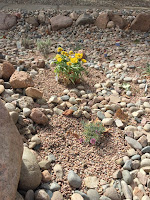By Sherie Caffey, Horticulture Coordinator, CSU Extension-Pueblo County
 |
| Newly transplanted Apache Plume |
Don’t put those shovels and gardening gloves away just
yet! There is still a little time left to plant perennials in your landscape.
When you think of planting new plants, Spring
definitely comes to mind. Fall, however, can be a good time to plant as well,
and many garden centers will be having end of season sales at this time, so you
can score some great deals! As long as the plants have time to establish good
roots before the first killing frost comes, they should be able to survive the
cold season. Down here in Southern Colorado, we won’t expect our first frost
until mid to late October, so there is still time.
If you are going to do some fall planting, don’t
forget the mulch! Fall planted perennials are more susceptible to frost heaving
in the soil due to their smaller root systems. Mulching your new plants will
stabilize the soil temperature, minimizing the effects of heaving. The mulch
will also prevent fluctuations in soil moisture, which will make your new
plants happy as well.
When you dig the hole for your perennials, make sure
it is wide enough, you want there to be plenty of room for the roots to spread
out and grow. You can amend the bottom of the planting hole with some good
fluffy garden soil. Be sure to mix the soil in with the native soil to prevent
an interface issue. To give your plant’s roots a boost, you can also add some
root stimulator, or beneficial mycorrhizae to the bottom of the hole.
 |
| Loosened root ball |
 |
| Bound root ball |
To give those roots a fighting chance, be sure to
break up the root ball a bit. Roots can become bound in pots and will have
trouble spreading out in the soil. You can score the root ball with a knife or
the plant marker in a few places to loosen the roots. I prefer to gently dig my
fingers into the root ball until it looks loose and messy. Remember, good
strong roots will lead to a good strong plant, so do everything you can to make
sure they have a good start.
Even if you are planting xeric plants, they will need to
be watered when they are young. After planting, give the plant one good round
of water, wait 5 or ten minutes, and give it another. This will ensure that the
water is soaki
 |
| Fall transplanted perennials |
I hope you are inspired to some last minute planting
before the cold season begins. Happy Fall and happy planting!

No comments:
Post a Comment